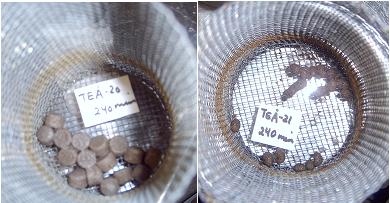|
Physical properties of feed
The objective is to development a feedback system to minimize physical damage of feed during transport in feed systems
Background The feed is commonly transported from a storage silo to the sea pens using a pneumatic conveying system, where the feed pellets are carried through pipes by an air stream. The collisions between pellets and pipe walls cause pellet breakage and formation of small particles, which represent loss, and the degree of breakage depends on the physical pellet quality. Consequently, high physical quality of the feed is demanded. However, the physical properties of the feed may influence the nutritional value of the feed. Suboptimal feed intake or feed utilisation resulting in reduced growth of the fish is difficult to quantify, but may cause considerable economic loss for the fish farmer. Two trials were performed 2008. In the first trial, breakage during feed conveying was investigated, whereas in the second trial, the effect of physical feed quality on nutritional values was investigated. Methods In the second experiment, the aim was to compare the effect of different physical feed qualities on the nutritional value. Two feeds were fed to rainbow trout kept at constant or fluctuating environment (temperature, salinity and oxygen saturation). One feed had high water stability, whereas the other disintegrated rapidly in water (Figure 1). The nutrient digestibility was estimated by analysing feed and faeces collected from an experiment previously performed by Nofima in collaboration with BioMar. Figure 1. After 4 hr shaking in water, the pellets with high water stability (left) were almost intact, whereas the pellets with low water stability (right) were highly disintegrated.
Results and discussion The results already available for the second experiment showed that, briefly, the feed intake was highest in trout fed the diet with low water stability, and when kept at constant environment. The growth tended to follow the same pattern, although the experiment was too short to produce significant differences in growth. Separated water and oil were also found in the stomachs of trout with the highest feed intake, which could potentially lead to fat belching. The apparent digestibility (%) of nutrients that was examined in the present project was in general highest in the diet with high water stability. This may be related to the feed intake, being lowest in fish fed this feed, and maybe having the longest transit time and thus being most effectively absorbed from the intestine. These results clearly showed that the physical properties of the feed affect its nutritional value, and that more attention should be paid to this relation, both in research and in commercial fish farming. |
Project leader
Erling Skjevrak (AKVA group)
Partners
AKVA Group ASA |

